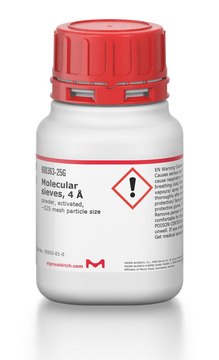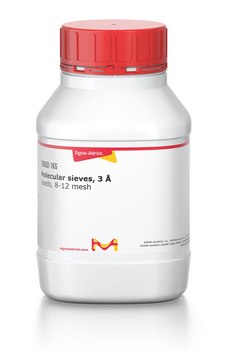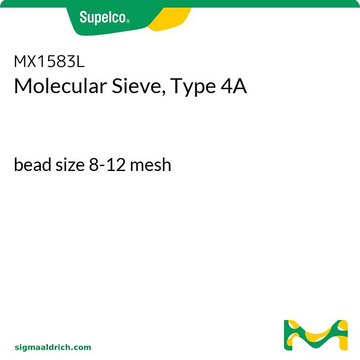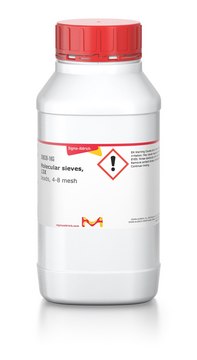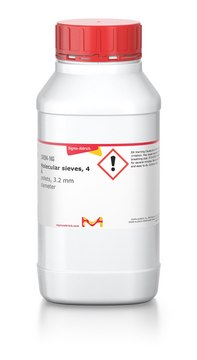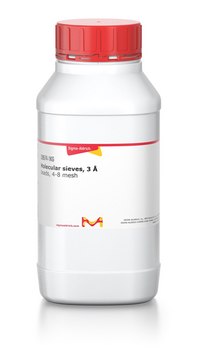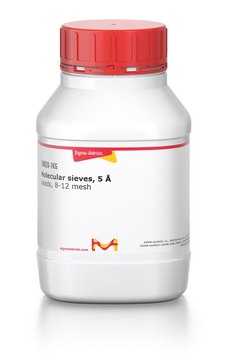Select a Size
Select a Size
About This Item
Recommended Products
form
beads
particle size
1.6-2.5 mm
pore size
4 Å
Looking for similar products? Visit Product Comparison Guide
Related Categories
General description
1. The preferential adsorption of one molecule over another depends upon pore diameter and mesh size.
2. The dynamic capacity of the silica gel for adsorbing a particular compound is governed by the internal surface area; the greater the surface area, the greater the dynamic capacity.
3. Rate of adsorption and sharpness of resolution are dependent chiefly on particle size and column packing; a fine particle size gives optimum sharpness of resolution.
4. Liquids are most readily adsorbed from solvents in which they are least soluble; a good solvent makes a good desorbing agent.
5. Highly polar liquids are readily adsorbed. Compounds having hydroxyl groups, or containing oxygen are strongly adsorbed.
6. For similar compounds, the higher the molecular weight the higher the selectivity.
7. For hydrocarbons of similar molecular weight, adsorptivity increases with the number of double bonds.
A saturated molecular sieve can be restored to its original capacity by regeneration, the principle of which involves changing the conditions surrounding the adsorbent to correspond to a very low equilibrium capacity. In general, the greater the difference between the equilibrium capacities of adsorption and regeneration, the more rapid and complete the regeneration.
The sieve may be regenerated in one of four ways:
1. Thermal reactivation –The maximum regeneration temperature for Silica is 300°C.
2. Pressure reactivation
3. Passing an appropriate fluid through the gel bed at normal temperature and pressure.
4. Displacement of adsorbates by passing a high concentration of molecules in a fluid through the bed.
Application
- Static dehydration in closed liquid or gas systems such as in packaging of drugs, electric components and perishable chemicals.
- Water scavenging in printing and plastics systems.
- Drying saturated hydrocarbon streams by adsorbing gases such as sulfur dioxide, carbon dioxide, hydrogen sulfide, ethene, ethane and propene.
Storage Class Code
11 - Combustible Solids
WGK
WGK 3
Flash Point(F)
Not applicable
Flash Point(C)
Not applicable
Choose from one of the most recent versions:
Already Own This Product?
Find documentation for the products that you have recently purchased in the Document Library.
Which document(s) contains shelf-life or expiration date information for a given product?
If available for a given product, the recommended re-test date or the expiration date can be found on the Certificate of Analysis.
How do I get lot-specific information or a Certificate of Analysis?
The lot specific COA document can be found by entering the lot number above under the "Documents" section.
How do I find price and availability?
There are several ways to find pricing and availability for our products. Once you log onto our website, you will find the price and availability displayed on the product detail page. You can contact any of our Customer Sales and Service offices to receive a quote. USA customers: 1-800-325-3010 or view local office numbers.
What is the Department of Transportation shipping information for this product?
Transportation information can be found in Section 14 of the product's (M)SDS.To access the shipping information for this material, use the link on the product detail page for the product.
Are Molecular sieves, 4 Å, Product 208604, pre-activated?
No. They should be activated by purging with a Bunsen burner, or by drying in an oven at 350-400°F for a few hours.
How do Molecular sieves, 4 Å, Product 208604, work?
A nominal pore diameter of 4 Å means that molecules with a smaller effective diameter will be absorbed, such as H2O, NH3, ethanol, CO2, H2S, SO2, ethylene, ethane and propylene. Conversely, it will exclude molecules with effective diameters greater than 4 Å, such as propane. Hence, it enjoys wide utility for drying solvents
What is the capacity of the Molecular sieves, 4 Å, Product 208604?
The capacity of these sieves is approximately 20% by weight.
My question is not addressed here, how can I contact Technical Service for assistance?
Ask a Scientist here.
Our team of scientists has experience in all areas of research including Life Science, Material Science, Chemical Synthesis, Chromatography, Analytical and many others.
Contact Technical Service
